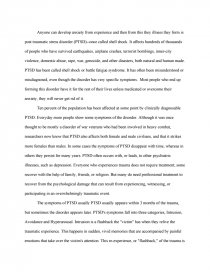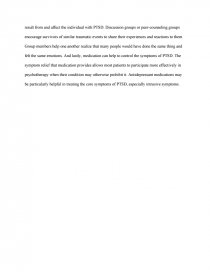Ptsd
Essay by review • November 10, 2010 • Essay • 729 Words (3 Pages) • 1,601 Views
Anyone can develop anxiety from experience and then from this they illness they form is post traumatic stress disorder (PTSD)--once called shell shock. It affects hundreds of thousands of people who have survived earthquakes, airplane crashes, terrorist bombings, inner-city violence, domestic abuse, rape, war, genocide, and other disasters, both natural and human made. PTSD has been called shell shock or battle fatigue syndrome. It has often been misunderstood or misdiagnosed, even though the disorder has very specific symptoms. Most people who end up forming this disorder have it for the rest of their lives unless medicated or overcome their anxiety, they will never get rid of it.
Ten percent of the population has been affected at some point by clinically diagnosable PTSD. Everyday more people show some symptoms of the disorder. Although it was once thought to be mostly a disorder of war veterans who had been involved in heavy combat, researchers now know that PTSD also affects both female and male civilians, and that it strikes more females than males. In some cases the symptoms of PTSD disappear with time, whereas in others they persist for many years. PTSD often occurs with, or leads, to other psychiatric illnesses, such as depression. Everyone who experiences trauma does not require treatment; some recover with the help of family, friends, or religion. But many do need professional treatment to recover from the psychological damage that can result from experiencing, witnessing, or participating in an overwhelmingly traumatic event.
The symptoms of PTSD usually PTSD usually appears within 3 months of the trauma, but sometimes the disorder appears later. PTSD's symptoms fall into three categories, Intrusion, Avoidance and Hyperarousal. Intrusion is a flashback the "victim" has when they relive the traumatic experience. This happens in sudden, vivid memories that are accompanied by painful emotions that take over the victim's attention. This re-experience, or "flashback," of the trauma is a recollection. It may be so strong that individuals almost feel like they are actually experiencing the trauma again or seeing it unfold before their eyes and in nightmares. Avoidance is when the person with PTSD starts to affect their relationship with others. The inability of people with PTSD to work out grief and anger over injury or loss during the traumatic event means the trauma can continue to affect their behavior without their being aware of it. Depression is a common product of this inability to resolve painful feelings. Some people also feel guilty because they survived a disaster while others, particularly friends or family, did not. Hyperarousal is when they can become suddenly irritable or explosive, even when they are not provoked. They may have trouble concentrating or remembering current information,
...
...


